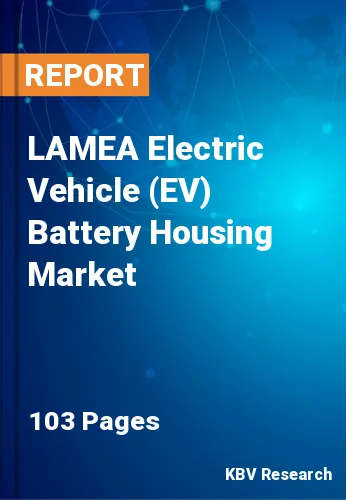The Latin America, Middle East and Africa Electric Vehicle (EV) Battery Housing Market would witness market growth of 14.5% CAGR during the forecast period (2023-2030).
In the event of a collision, the battery housing is designed to absorb and dissipate impact forces, contributing to the overall safety of electric vehicles. The strategic placement of the battery pack, coupled with the materials used in the housing, enhances crash safety and minimizes the risk of battery damage. Battery housing is a hub for various electronic components, including battery management systems (BMS) and monitoring sensors. These systems continuously monitor the health and performance of the batteries, providing real-time data to both the vehicle and the driver. Integration with vehicle electronics allows for advanced features such as regenerative braking, energy management, and predictive maintenance.
EV battery housing is often integrated into the chassis or frame of the electric vehicle, contributing to the vehicle's overall structural integrity. This integration enhances crash safety by providing additional reinforcement and impact absorption. It also influences weight distribution, contributing to improved handling and stability. Advanced EV battery housing designs often incorporate modular and scalable features. Modular designs allow flexibility in adapting to different vehicle models and sizes, facilitating easier maintenance and upgrades. Scalable designs enable manufacturers to use similar battery housing structures across different vehicle platforms, streamlining production processes and reducing costs.
According to the International Trade Administration, Saudi Arabia sold 35% and nearly 52% of the vehicles in 2020 in the Gulf Cooperation Council and the MENA region. The adoption of electric vehicles in Dubai encourages innovation in EV technologies, including advancements in battery technologies and housing solutions. Dubai’s emphasis on sustainability contributes to its green image and attracts environmentally conscious tourists. According to the Dubai Water and Electricity Authority, the number of EVs in Dubai is predicted to be about 7,331 in 2023 and 12,852 by 2025. This supports Dubai's Green Mobility Strategy 2030, which mandates that by 2030, 30% of public sector vehicles and 10% of all new vehicle sales will be electric or hybrid. Therefore, due to the above-mentioned factors, the market will grow significantly in this region.
The Brazil market dominated the LAMEA Electric Vehicle (EV) Battery Housing Market by Country in 2022, and would continue to be a dominant market till 2030; thereby, achieving a market value of $579.5 Million by 2030. The Argentina market is showcasing a CAGR of 14.8% during (2023 - 2030). Additionally, The UAE market would register a CAGR of 14% during (2023 - 2030).
Free Valuable Insights: The Worldwide Electric Vehicle (EV) Battery Housing Market is Projected to reach USD 24.3 Billion by 2030, at a CAGR of 13.2%
Based on Vehicle Type, the market is segmented into Passenger Car and Commercial Car. Based on Material, the market is segmented into Aluminium, Steel and Others (Carbon Fibre & Carbon Glass). Based on countries, the market is segmented into Brazil, Argentina, UAE, Saudi Arabia, South Africa, Nigeria, and Rest of LAMEA.
By Vehicle Type
By Material
By Country
Our team of dedicated experts can provide you with attractive expansion opportunities for your business.

